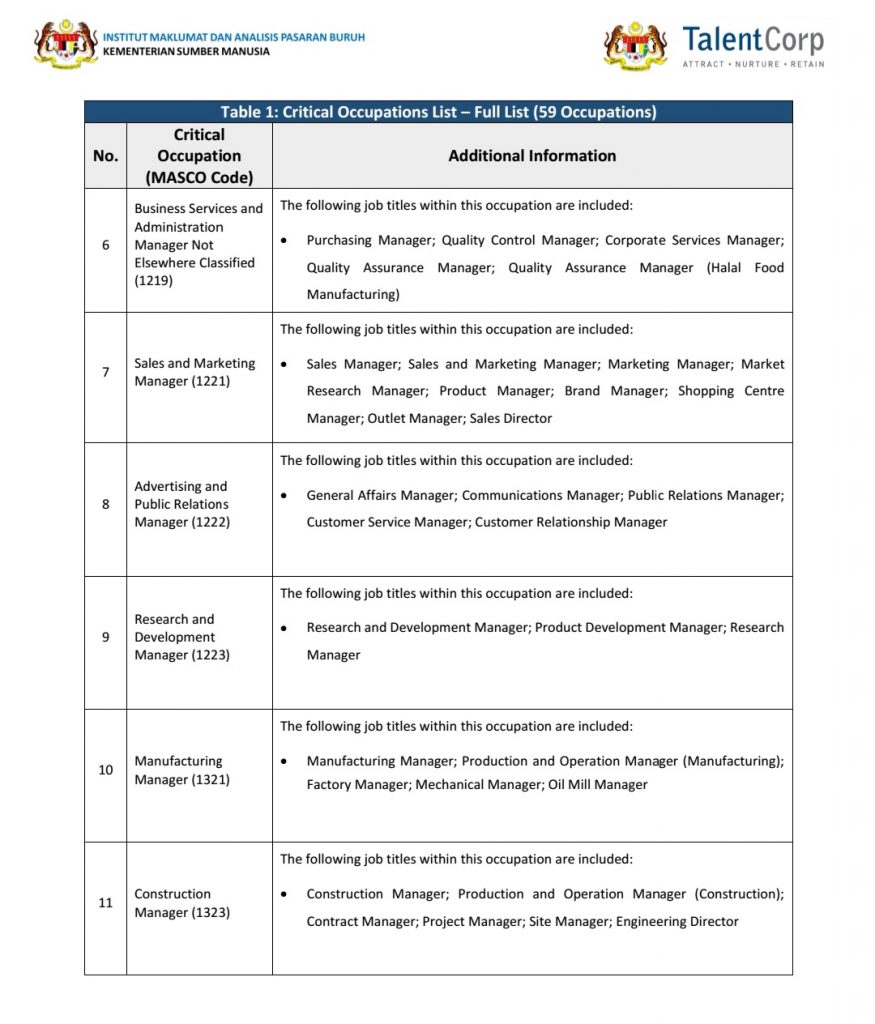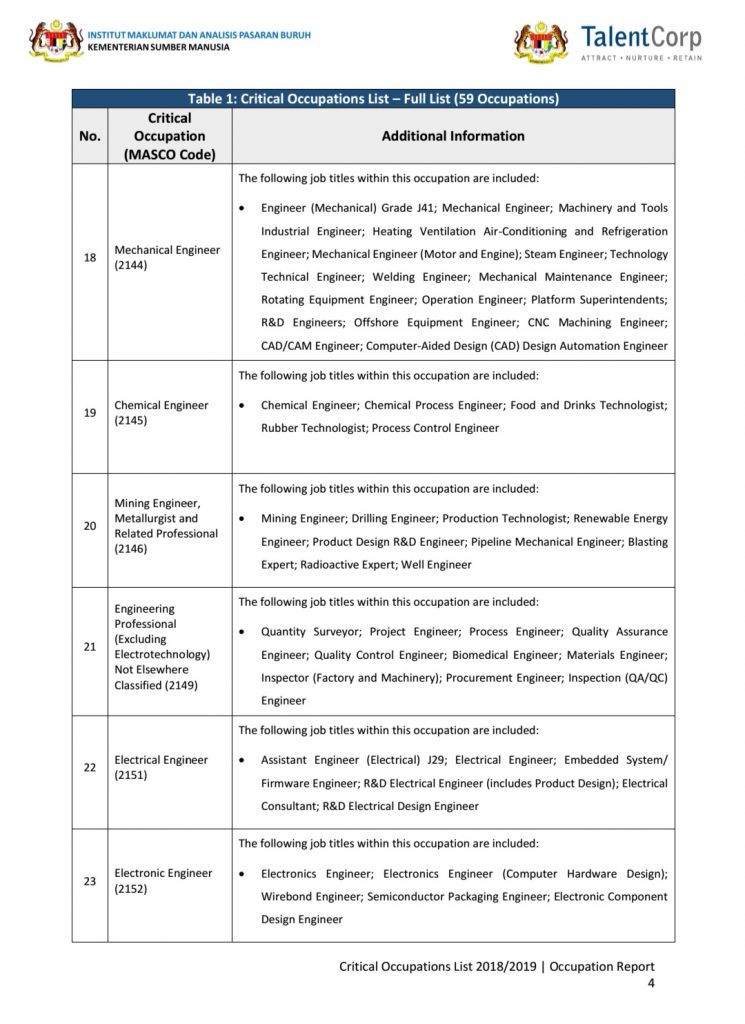Critical Occupations List (COL) - Identifying Malaysia’s Talent Shortages for Future Jobs
Sourced by EduSpiral Consultant Services for your Benefit. For more information contact 01111408838
The aim of education is to secure a job in the future that has demand and a high salary. This will ensure that you will have job security and stable income to be able to sustain your lifestyle and more importantly to take care of your family.According to the Critical Occupations List, what's in demand are communication skills, English language proficiency and problem solving expertise. The country is also in need of more electric and electronic engineers, early childhood educators, finance managers, chemists, manufacturing professionals and software developers among others.
The 2018/2019 Critical Occupations List (COL) highlights 59 middle- and high-skilled occupations that are sought-after, strategic and in high demand. The COL keeps abreast of changing labour market demands associated with new technologies, automation and Industry 4.0. It was developed by agencies under the Human Resources Ministry and in collaboration with the World Bank. On Sept 12, the World Bank released its "Monitoring Occupational Shortages: Lessons from Malaysia’s Critical Occupations List” report, a case study of the COL.
When choosing the right course to study in Malaysia, one important criteria that students should look at is the job demand. Choosing to study a course that has future potential high job demand and salary would ensure that you have a higher chance of a successful career that would support your lifestyle goals. If you don’t plan carefully, you may end up studying a course that has no job demand after you graduate. This would be an incredible waste of your time and money.
Therefore, at EduSpiral Consultant Services, we do our research on the job demand for the careers in Malaysia and Salary Reports in order to best advise our students on what to study based on facts and evidence. I have researched articles such as the one below so that I can advise students properly and they can have a higher chance of getting a job that's in demand with high salary in Malaysia and globally.
You might also be interested to read these:
- Study Courses that has High Job Demand in Malaysia
- Top 20 Courses to Study in Malaysia that has High Job Demand & Stable Salary
- Top 10 Best Courses to Study in Malaysia
- Top 10 Jobs in Malaysia
- Malaysia’s 28 Top Jobs in Demand in Future with High Salaries
- Top 10 Degree Courses in Malaysia with Highest Starting Salaries
Critical Occupations List (COL) 2018/2019 - Understanding the Job Shortage So that You Can Choose the Right Course for Future Jobs
Collated on an annual basis by the Critical Skills Monitoring Committee (CSC), led by TalentCorp and the Institute of Labour Market Information and Analysis (ILMIA) under the Ministry of Human Resources (MOHR), the COL was developed based on recommended international practices. Its compilation process is based on regular consultations with the World Bank.
Because the COL is developed with the data from employers, it provides a big picture of the skills and occupations that are in demand within the industries. It also gives you a better idea of the occupations that will be prioritised by policymakers, especially in the aspects of immigration, education and upskilling opportunities.
COL will continue to expand to create a comprehensive map of Malaysia’s most demanded current and future skills and talent towards Industrial Revolution (IR) 4.0.
The report covers 18 economic sectors:
- Agriculture, Forestry and Fishing
- Mining and Quarrying
- Manufacturing
- Electricity, Gas, Steam and Air Conditioning Supply
- Water Supply; Sewerage, Waste Management and Remediation Activities
- Construction
- Wholesale and Retail Trade; Repair of Motor Vehicles and Motorcycles
- Transportation and Storage
- Accommodation and Food Service Activities
- Information and Communication
- Financial and Insurance/Takaful Activities
- Real Estate Activities
- Professional, Scientific and Technical Activities
- Administrative and Support Service Activities
- Education
- Human Health and Social Work Activities
- Arts, Entertainment and Recreation
- Other Service Activities
What is a Critical Occupation?
Occupations are considered critical if they are skilled, sought-after, and strategic. The Critical Occupations List is primarily concerned with identifying shortages in occupations that are associated with Malaysia’s growing knowledge-based economy. To accomplish this, the COL is focused on identifying occupations that are skilled. The COL is also interested in determining whether there are mismatches between employers’ demand for certain occupations and the supply of the skills associated with these occupations.As a result, the COL seeks to identify shortages in occupations that are sought-after by employers. Finally, the COL is designed to be a tool to help policymakers make decisions. Thus, even after identifying shortages in skilled occupations an occupation is only considered to be critical if filling that occupational shortage is consistent with Malaysia’s strategic economic development objectives.
The 2018/2019 Critical Occupations List (COL) - 59 Jobs in Demand in Malaysia
MASCO code MASCO title- 1121 Managing Directors and Chief Executives
- 1211 Finance Managers
- 1212 Human Resource Managers
- 1213 Policy and Planning Managers
- 1214 Business Services Managers
- 1219 Business Services and Administration Managers Not Elsewhere Classified
- 1221 Sales and Marketing Managers
- 1222 Advertising and Public Relations Managers
- 1223 Research and Development Managers
- 1321 Manufacturing Managers
- 1323 Construction Managers
- 1511 Information and Communications Technology Managers
- 2113 Chemists
- 2114 Geologists and Geophysicists
- 2121 Mathematicians, Actuaries and Statisticians
- 2141 Industrial and Production Engineers
- 2142 Civil Engineers
- 2144 Mechanical Engineers
- 2145 Chemical Engineers
- 2146 Mining Engineers, Metallurgists and Related Professionals
- 2149 Engineering Professionals (Excluding Electrotechnology) Not Elsewhere Classified
- 2151 Electrical Engineers
- 2152 Electronic Engineers
- 2166 Graphic and Multimedia Designers
- 2173 Aircraft Pilots and Related Professionals
- 2182 Manufacturing Professionals
- 2263 Environmental and Occupational Health and Hygiene Professionals
- 2311 University and Higher Education Professional Teachers
- 2342 Early Childhood Educators
- 2411 Accountants
- 2412 Financial and Investment Advisers
- 2413 Financial Analysts
- 2431 Advertising and Marketing Professionals
- 2511 Systems Analysts
- 2512 Software Developers
- 2514 Applications Programmers
- 2519 Software and Applications Developers and Analysts Not Elsewhere Classified
- 2522 Systems Administrators
- 2523 Computer Network Professionals
- 2529 Database and Network Professionals Not Elsewhere Classified
- 3112 Civil Engineering Technicians
- 3113 Electrical Engineering Technicians
- 3115 Mechanical Engineering Technicians
- 3119 Physical and Engineering Science Technicians Not Elsewhere Classified
- 3122 Manufacturing Supervisors
- 3129 Other Supervisor Not Elsewhere Classified
- 3322 Commercial Sales Agents
- 3641 Chefs
- 4224 Receptionists
- 7212 Welders and Flame Cutters
- 7233 Agricultural and Industrial Machinery Mechanics and Repairers
- 7412 Electrical Mechanics and Fitters
- 7512 Bakers, Pastry, Pasta and Confectionery Makers
- 7621 Tailors, Dressmakers, Furriers and Hatters
- 8141 Rubber Products Machine Operators
- 8182 Steam Engine and Boiler Operators
- 8189 Stationary Plant and Machine Operators Not Elsewhere Classified
- 8332 Heavy Truck and Lorry Drivers
- 8341 Mobile Farm and Forestry Plant Operators
What is the COL used for?
The COL will be used to refine human-capital related public policies, such as: upskilling, scholarship, higher education, immigration, and technical vocational education and training (TVET). It is currently being used for several policies that are related to human capital:TalentCorp’s Returning Expert Programme (REP) and Residence Pass-Talent (RP-T) incorporates the COL as one of the key approval criteria for applications.
The Ministry of Higher Education (MOHE) uses the COL as a reference to review new programmes as proposed by public institutions of higher education.
Why doesn’t the COL provide specific numbers, e.g. how many engineers will we need in the next five years?
Based on the experiences of advanced economies, attempts to predict the exact demand of occupations are likely to be inaccurate, because they are based on many assumptions. The COL aims to suggest which occupations will have a labour shortage, and not on the extent of the shortage.Example: while many oil and gas firms forecast a large need for skilled workers in the upstream sector, the unexpected fall in oil prices and uncertain timing of its persistence have led companies to freeze hiring; some have even retrenched workers. Forecasts such as “we need 30,000 engineers by 2020” might be inaccurate and result in an oversupply of labour (leading to problems such as graduate unemployment).
Countries such as the UK, Australia, and Canada have also adopted a similar approach.
How do companies benefit from the COL?
Companies can give input to the COL via the Call for Evidence (CFE) survey, to share their key talent needs and hiring challenges. Based on the COL, TalentCorp can drive for meaningful interventions that are reflective of industry’s talent needs.The COL can be used as a reference to guide relevant programmes. For example, TalentCorp’s REP and RP-T gives more consideration for applicants working in a critical occupation. This benefits companies who hire talents through TalentCorp’s initiatives.
Does the COL take into account issues of the global economy, current government interventions, and other issues like government mega projects (e.g.: Malaysia High Speed Rail, East Coast Rail)?
Yes. The COL draws data from national surveys and companies feedback. Any issue that influences employers’ hiring policies will therefore also be reflected in the COL results. Such issues include (but not limited to) the general state of economy in the industry, government regulations, and national development plans.Why doesn’t the COL rank occupations by how critical they are (in terms of the acuteness of shortages/criticalness)?
The COL suggests which occupations appears to be in demand and are strategic to the Malaysian economy. While the COL indicates which occupations received more evidence, it does not compare how critical each occupation in relation to one another. The decision on the criticalness of each occupation is subjective to the users of the COL.
How does the COL benefit talent?
Directly: Companies, industry associations/regulators, policy makers and the general public can use the COL as a reference to understand the trends of different occupations in Malaysia.Indirectly: The COL is used as a reference to ensure that human capital related initiatives/policies will better target industry talent needs. For example, new courses introduced at universities will go through a committee panel that uses the COL to assess whether the courses will lead to positive employment outcomes for university graduates.
Does the COL also cover future jobs in demand?
The COL provides information on the skills that employers need in future.In the CFE survey, employers are asked whether they plan to introduce new production techniques in future, and if they expect to expand their workforce in specific occupations. Bottom-up evidence on future labour shortage is used together with top-down evidence to decide if an occupation should be included in the COL, and also to identify emerging trends in future skills needed in the economy. However, the COL does not differentiate between short-term need and long-term need for occupations – this is why the COL is updated every year, to provide constant updates.
If an occupation appears in the COL for several years, it suggests a long-term demand for this occupation. Longer-term interventions could be necessary (e.g. education and training policies). Conversely, if an occupation appears in the COL for the first time, shorter-term measures could be more appropriate (e.g. migration policies, short-term training) in addressing its shortage
OCCUPATIONS ON THE 2018/2019 CRITICAL OCCUPATIONS LIST
The Critical Occupations List (COL) shows occupations that are skilled, sought-after, andstrategic across 18 sectors in Malaysia.










No comments:
Post a Comment
Please leave your comments and questions